
Table of Contents
Share this Publication
- Download PDF
- Print This Publication
- Cite This Publication Copy Citation
“Mexico Country Outlook 2024” (Houston: Rice University's Baker Institute for Public Policy, January 18, 2024), https://doi.org/10.25613/QR1D-0856.
This report was written collaboratively by experts from the Baker Institute Center for the U.S. and Mexico and other contributors. Learn more about the annual Mexico Country Outlook conference and accompanying report.
Introduction
Each year, the Center for the U.S. and Mexico at Rice University’s Baker Institute for Public Policy surveys a number of experts for the annual Mexico Country Outlook. These experts are tasked with anticipating the opportunities and challenges in Mexico’s political, social, and business environments in the coming year for policymakers, industry leaders, and the general public. The resulting report addresses themes as varied as Mexico’s politics and democracy, regulatory environment, economy, legislative agenda, human mobility, public safety and security, education, health care, and political and diplomatic relationships.
This report presents the forecast for Mexico in 2024. It considers the country’s uncertain political landscape, complex legislative and regulatory environment, social and economic challenges, public safety and security barriers, and increasingly difficult relationship with the United States. More information about the Mexico Country Outlook and access to reports from previous years can be found here.
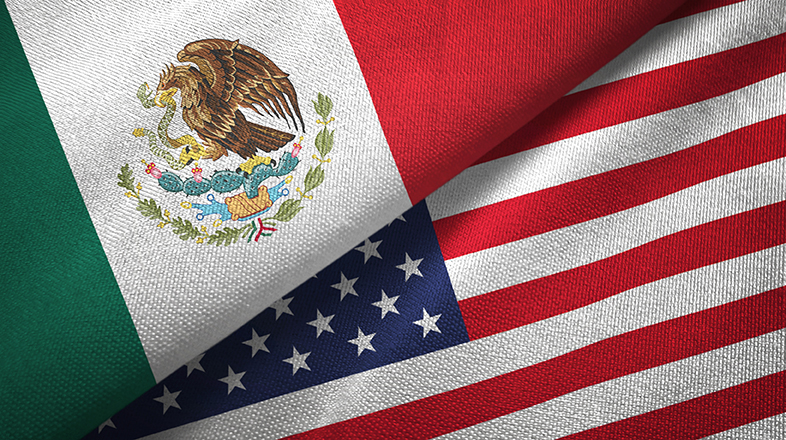
I. Executive Summary
Mexico’s outlook for 2024 contains both reasons for optimism and daunting challenges. Encouragingly for some industry leaders, a complicated geopolitical environment has motivated the United States to craft a new industrial policy that involves reshoring much of its manufacturing to North America. Mexico is in an enviable position thanks to its proximity to U.S. markets, which continue to display robust demand for Mexico’s goods and services, and the favorable investment environment stemming from the United States-Mexico-Canada Agreement (USMCA). A positive trading and investment environment, boosted by the post-pandemic recovery, is a testament to this, and likely guarantees that this will not soon change.
However, Mexico’s challenges in the coming year are enormous. They mostly result from questionable political choices and faulty domestic policy. On the political front, Mexico is experiencing the same populist wave seen by many other countries around the world. This has resulted in a presidency that is set to leave the country’s institutions much weaker than they were previously. Mexico’s checks and balances are eroding in a way not seen since the 1990s, and a forceful centralization of decision-making has inserted a high, dangerous degree of uncertainty and arbitrariness into its policymaking process.
Mexico’s electoral system is also weakened, and its political actors are likely to question the results of the upcoming elections on June 2, 2024. The leftist National Regeneration Movement (MORENA), the party of President Andrés Manuel López Obrador, is widely expected to interfere with the elections, making them less free and less fair. The danger of post-electoral conflict is thus much higher than it was in 2018 or 2021. Still, with the country remaining divided, the opposition will likely have a good showing even if it ultimately loses the elections. However, this political environment will detract from Mexico’s favorable business environment and slow down investment decisions.
The policy environment is also likely to be quite complex in 2024. This is partly a result of decisions made by the López Obrador administration over the past five years. Most of these policy choices will be difficult to reverse quickly. Mexico now faces chronic underinvestment in education, health care, and infrastructure, as well as a severely underfunded civil service. This has led the government to transfer many functions previously in the hands of civil servants to a less-competent military. Demilitarizing the government will pose an enormous challenge in the future.
Investors will want to see progress on all of these fronts before they trust that the country can provide the workforce, goods and services, and administrative competence needed to make their investments profitable. The few major projects that the government has actively invested in, including the Dos Bocas refinery, Mayan Train, and outer Mexico City airport, are unlikely to make up for underinvestment in nearly all other sectors.
In the key area of energy, Mexico is unlikely to correct course quickly. Its oil production is stagnant, refining remains a losing bet, and electricity production is already at capacity and insufficient for continued business expansion in 2024 and beyond. Electric transmission has also been underinvested in, making it unlikely that power will be available in the right places. The only promising project is the Trans-Isthmus passage linking the port of Salina Cruz in Oaxaca with the port of Coatzacoalcos in Veracruz. It is not expected to be completed by 2024, however, and perhaps not even in the near future.
Corruption and organized crime are also areas of high concern. The government has no coherent strategy for lowering corruption levels, and Mexico has lost ground in nearly every global corruption index. Its passive public safety and security strategy is essentially a “Pax Mafiosa” with organized crime, or an agreement to not interfere in criminal activities.
This strategy will rear its ugly head in 2024. Criminal organizations may even become an important electoral ally of MORENA in the June 2024 elections; they showed their ability to intimidate, and even kill, opposition candidates and poll workers in 2021, and they are likely to push ahead in 2024.
Organized criminal activity will likely be an important subject during the 2024 campaign season. It may also be a major deterrent to international investment in Mexico, as most businesses must now consider the safety of their physical assets and operatives, along with the uncertainty of the policy environment.
Fiscal discipline and low taxes are the two shining spots of the López Obrador administration, but they are likely to go out the window in 2024. The budget for the 2024 fiscal year already borrows heavily to make up for a shortfall in revenue and inefficient spending, in addition to the likely embezzlement of public funds to favor MORENA candidates in the election.
However, most of the major challenges Mexico is set to face in 2024 can be still be tackled. They primarily stem from the choices of its sitting president, with an obedient Congress and a political class unwilling to wrest power from the country’s chief executive. These choices, however, are likely to become structural if the next administration, which takes office on Oct. 1, 2024, does not immediately reverse many of these policies. If it maintains course, Mexico’s ability to capture the benefits of its geographic position, a favorable geostrategic environment, and the advantages that stem from the USMCA will be diminished.
Finally, Mexico’s foreign policy, which we expect to remain complicated through 2024, deserves its own analysis. Several areas are proving particularly contentious for the U.S.-Mexico relationship. First, Mexico has shown significant hesitancy on issues that are of extreme importance to the United States. These include stemming the flow of irregular migration into the U.S. and combatting the illegal import of fentanyl, which kills over 100,000 Americans a year. Second, numerous trade disputes have arisen over Mexico’s reluctance to open its energy market, disagreements over key agricultural products, and China’s apparent laundering of steel and aluminum through Mexico’s exports to the United States. Lastly, Mexico’s cordial relations with Latin American dictatorships, such as Cuba, Venezuela, and Nicaragua, and its reluctance to side with American interests in both Ukraine and the Middle East have irked Washington.
These choices are likely to continue slowing down U.S.-Mexico cooperation. However, the U.S. government will likely pay little attention to Mexico’s foreign policy through 2024, mostly due to major distractions in Asia, the Middle East, Europe, and at home, including its own presidential election in November 2024.
II. Shifting Political Landscape
The June 2 elections will be Mexico’s most consequential event of 2024. They will be the largest elections ever held in the country, with the presidency, all 500 Chamber of Deputies seats and 128 Senate seats, nine governorships, and thousands of mayoral, city council, and state legislator seats on the ballot. López Obrador remains popular, although no more than past presidents have at the same point in their term. His government is likely preparing to tilt the balance in favor of his hand-picked successor, former Mexico City Mayor Claudia Sheinbaum.
Even so, some 65% of Mexicans agree that López Obrador’s public safety and security policies are less than optimal, and many of his other policy choices are nearly as unpopular. Between 2018 and 2021, one-third of his electoral base abandoned the president and his coalition, and only about half of his voters showed up in a self-organized recall election in 2022. Moreover, the Mexican middle class remains upset at his dramatic budget cuts to education, health care, infrastructure, public safety and security, and many other services previously provided by their government.
Additionally, the opposition, which is composed of the National Action Party (PAN), the Revolutionary Institutional Party (PRI), and the Democratic Revolution Party (PRD), has managed to stay together and nominated Sen. Xóchitl Gálvez as its presidential candidate. Gálvez is a charismatic and competitive candidate, facing a much less inspiring and uncharismatic Sheinbaum.
Finally, the country’s electorate remains divided; the president’s coalition and the opposition draw approximately 45% of voters each. But many Mexicans remain undecided, and the race is likely to be competitive. Much will depend on the decision of Citizens’ Movement (MC), another Mexican political party, to enter the presidential race.
In October 2023, Nuevo León Gov. Samuel Garcia announced he would take the first step to compete for the MC party’s nomination for president. His bid for the nomination will likely be successful. With that, Gálvez’s climb will become more difficult, but not impossible. Moreover, it is not inconceivable for García to climb to the top — over Sheinbaum and Gálvez — especially since he could easily become a disruptive candidate that galvanizes many of the Mexican electorate’s political anxieties.
Figure 1 — Elections in Mexico in 2024
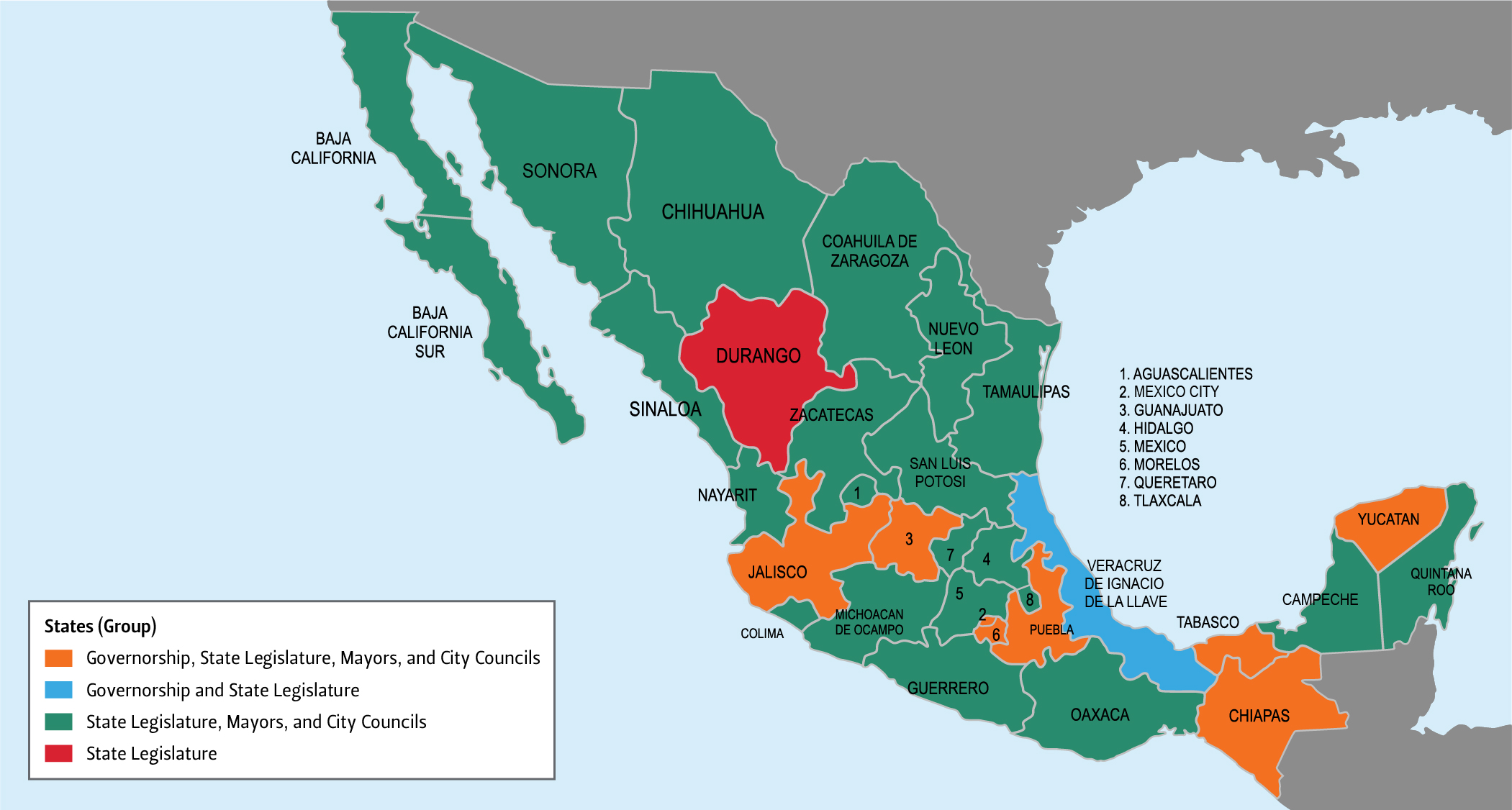
Note: All 32 states will hold general federal elections for the presidency and both chambers of Congress. Individual states will hold various local elections, indicated by color code.
A balanced political future will also depend on voter turnout; the higher the turnout, the better the prospects will be for the opposition. A depressed turnout, where only the loyal vote shows up and the current government tilts the statistical balance in its favor, will likely result in a MORENA victory and a much more uncertain future.
The 2024 elections could result in three possible scenarios:
- The MORENA coalition wins the elections. The opposition would likely protest and even mobilize, but would acknowledge its defeat in the end.
- The opposition achieves a narrow victory, which would not be recognized by the MORENA coalition. Both sides would mobilize their bases, and there would be a period of political polarization. In this scenario, institutions hold, and sufficient and legitimate actors emerge to manage the post-electoral conflict. The result would be a negotiated transition.
- The opposition wins, and MORENA refuses to acknowledge its defeat. Each side mobilizes its base, but there are no sufficient and legitimate actors to mediate the post-electoral conflict, resulting in a collapse of governance and an even more divided country. This scenario is possible precisely because the current government has signaled that it will mobilize its resources in favor of its candidate and has already weakened Mexico’s electoral institutions.
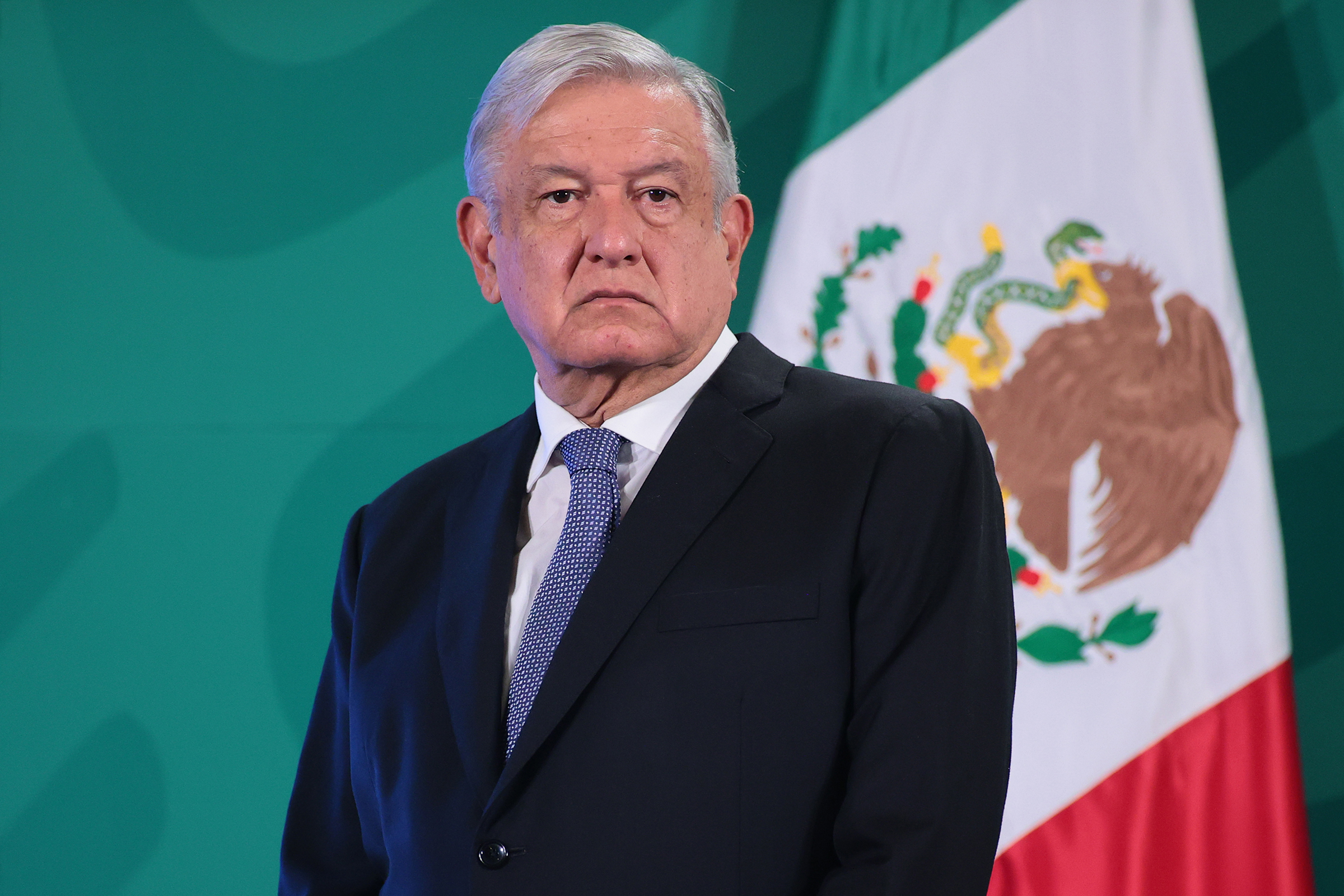
In the end, nearly all potential scenarios will send Mexico into a greater degree of political uncertainty, and we expect democratic backsliding to continue well past 2024. This could raise further doubts in the U.S. about Mexico’s status as a free market democracy.
What will governability look like after the June 2 elections? Currently, MORENA has a simple majority in Mexico’s Chamber of Deputies. Of the 500 members of the lower house, 201 are members of MORENA, and 275 belong to the party’s coalition with the Green Party (PVEM) and the Workers Party (PT). MORENA also currently holds 46% of Senate seats, with 60% held by the coalition. Neither of these numbers is sufficient to change the Mexican Constitution, which López Obrador has wanted to do.
Next year, however, the main goal of the MORENA-led coalition will be to gain a two-thirds congressional majority and increase its number of seats in the Senate. This would achieve a supermajority and could help it to change the constitution in whole or in part.
This presents difficult scenarios for governability. There are three scenarios to keep in mind toward the end of 2024, depending on the election’s outcome:
- The opposition wins and Gálvez is elected president, but no side holds a majority. This is somewhat likely.
- Sheinbaum wins the presidency, but Congress remains divided and is thus unable to change the constitution. This is the most likely scenario.
- Sheinbaum wins the presidency, and the MORENA coalition gains a supermajority in Congress — enough to change the constitution in whole or in part. This scenario is unlikely, but it would represent a serious challenge to Mexico’s constitutional order.
Of these, the third scenario would be the most disruptive, since Sheinbaum is considerably more radical than López Obrador and possibly much more politically effective than him. She is also considerably more ideological in her thinking and would come into power much better prepared than López Obrador was when he took office. For these reasons, the last scenario would be the most dangerous.
III. Legislative and Regulatory Environment
Several legislative initiatives passed in 2023 whose implementation and litigation will extend into 2024. Mexico will also see new regulatory changes in the coming year regarding nearshoring.
Legislative Initiatives Under Discussion
Mexico’s Judicial Budget
During his administration, López Obrador and MORENA have ramped up attacks against Mexico’s judicial branch. Among other legislation, the party introduced a bill that eliminates 13 trust funds that provide benefits and pensions for federal judiciary workers, undermining the branch’s autonomy. The bill was passed by the Chamber of Deputies and the Senate in October 2023 and published in the country’s Federal Official Gazette later that month, making it law. This will not be the end of the matter, however.
The bill’s supporters contended that its purpose was to cut privileges enjoyed by Supreme Court justices, magistrates, and judges. Those who opposed it argued that the benefits covered by the trusts were essential to guarantee workers’ labor and social security rights, including pensions, health coverage, and other retirement benefits.
More than 50,000 judicial branch workers are expected to challenge the bill through “amparo,” a unique Mexican legal instrument that allows injunctions and even personal exemptions from the application of a law or decision of an administration on the basis that it violates labor rights. Members of the opposition will also bring a constitutional challenge, but it is unclear whether they have standing.
The Supreme Court will thus be placed in the awkward position of ruling in a case in which it has an interest. This will raise questions about the court’s impartiality and authority, and any judicial outcome will be bad for Mexico’s rule of law. Meanwhile, López Obrador will use the situation to strengthen the public’s perception that the courts are meddling in politics. Considering that 2024 is an election year, we expect he will continue to attack the country’s judicial branch and its judges.
Labor Reform
The Chamber of Deputies is considering a constitutional amendment to Article 123 that would reduce the workweek from 48 hours to 40. The reform would bring changes to the country’s Federal Labor Law. Supporters of the bill argue that the change would bring Mexico in line with most member countries of the Organization for Economic Cooperation and Development (OECD). The bill’s opponents argue that the amendment would negatively impact employers, which would need to choose between hiring more workers or paying more overtime hours. Both options would raise the cost of goods and services and, in their view, cause Mexico to become less competitive with other countries that provide cheap labor.
The bill is likely to pass; in recent years, Congress has been very receptive to legislation aimed at expanding workers’ rights. For example, it recently approved a bill raising the country’s minimum wage and doubling the number of annual leave days from six to 12 after a year of employment. It is important to note, however, that constitutional amendments require a two-thirds majority in both chambers of Congress to pass.
2023 Regulations With Impacts in 2024 and Beyond
Nearshoring Tax Incentives
On Oct. 11, 2023, López Obrador’s Finance Ministry issued a decree granting tax benefits to companies from 10 export sectors, including the automotive, semiconductor, pharmaceutical, agrochemical, and fertilizer industries. Companies currently located in Mexico or planning to relocate operations there can deduct investments in new fixed assets (including machinery and equipment) and expenses on technical training. The tax benefits for the accelerated tax depreciation for new fixed assets apply from Oct. 12, 2023–Dec. 31, 2024, and deductions on technical training apply through 2025. The incentives are designed to boost nearshoring investment by attracting companies that want to relocate their offshore operations to places closer to their North American customers.
This is a good first step from the federal government to increase foreign direct investment (FDI). The decree adds to efforts by state and municipal governments to incentivize companies to relocate operations to their jurisdictions. Another good sign: The federal government did not limit tax benefits to specific regions of the country, as it did with previous tax benefit decrees that only applied to Mexico’s southern region.
IV. Presidential Elections Will Raise Economic Uncertainty
Mexico’s economic performance improved in 2023. The economy is expected to grow 3.2%. It has been bolstered by strong consumption resulting from increases in real wages and labor market improvements; investment, particularly in construction, auto production, and nearshoring activity; and remittances (money sent by Mexican migrants abroad, particularly in the U.S.). Another contributing factor is the better-than-expected growth of the U.S. economy, which increases Mexico’s exports. López Obrador’s major infrastructure projects have provided another boost, but their long-term impact could be insignificant to the economy. In 2024, the economy is expected to grow by 1.8%–2.5% (Figure 2).
Although fiscal policy will loosen, its impact on economic growth will be limited by binding constraints on capacity, tight monetary policy, and slower economic growth in the U.S., Mexico’s main trading partner. The dynamism of private consumption and investment can be expected to continue next year. Remittances, manufacturing exports to the U.S., and FDI resulting from increased nearshoring activity in Mexico will also help support the country’s economy.
However, unpredictability in the investment and business environment will pose economic challenges. Since López Obrador took office in 2018, his administration has created enormous uncertainty by making economic policy decisions based on ideological, rather than pragmatic, grounds. This has affected potential investment and thus FDI, which means that Mexico is not taking full advantage of nearshoring opportunities and the benefits of the USMCA for Mexico.
With the 2024 elections approaching and López Obrador continuing his erratic style of policymaking, uncertainty is likely to continue, and companies can be expected to postpone and even cancel their investment in the country throughout the year. The second half of the year following the June elections will bring more certainty.
Figure 2 — GDP Growth Rates in the US and Mexico (1990–2024)
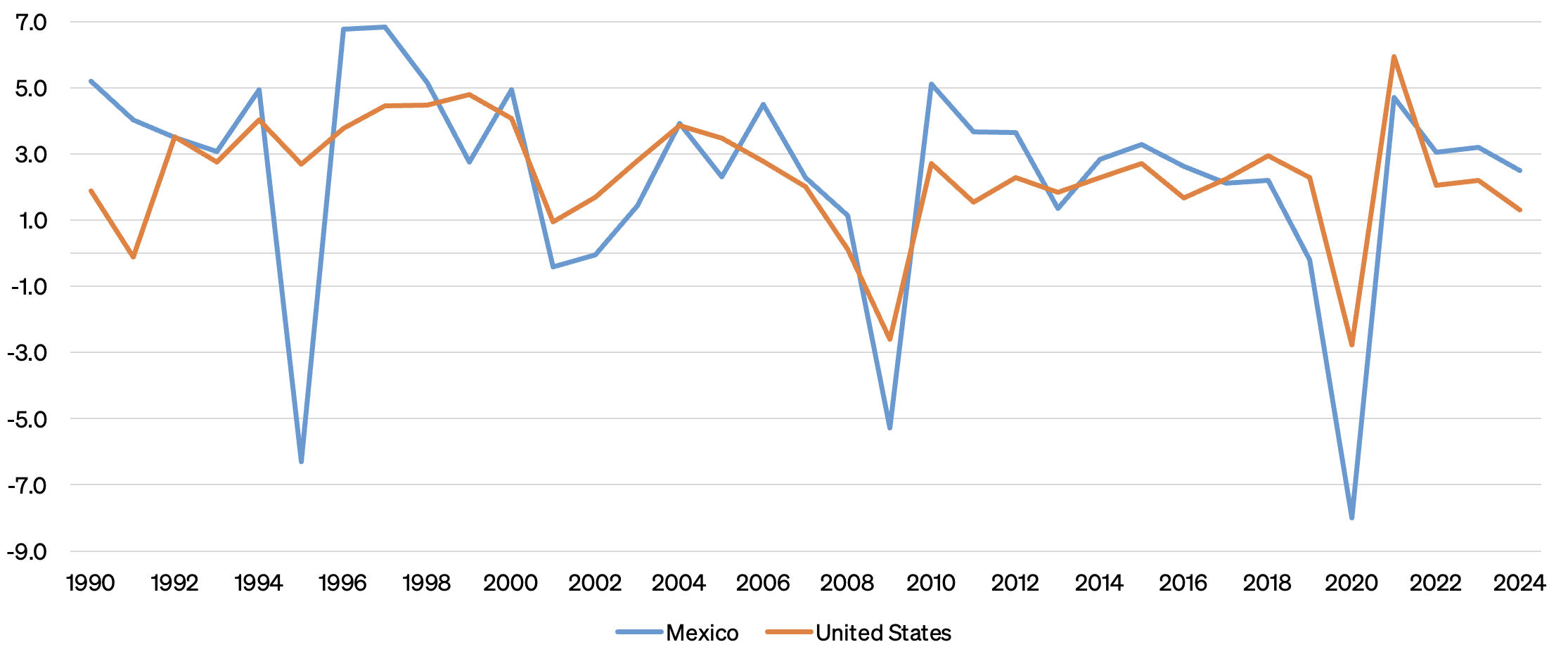
Note: 2023 and 2024 rates are authors’ estimates.
Factors Influencing Mexico’s Economic Performance in 2024
Mexico’s economic performance in 2024 will be affected by the following factors:
- Its biggest budget deficit in decades. A deficit of 4.9% of GDP in 2024 will put pressure on public finances and threaten the Mexican government’s credit rating.
- Flat tax revenues. The Mexican federal government has not increased taxes in five years and is not likely to do so in 2024, leading to the growth of public debt next year.
- Public spending. For 2024, the federal government is planning to allocate 9 trillion pesos (26% of GDP), or $510 billion, on public spending. However, the majority of this spending is already designated. It will go toward interest payments on debt, social program liabilities (mainly pensions), a handful of the president’s pet infrastructure projects, and federal resources that will be delivered to states. The professionalization of the civil service and investment in development programs will have to wait another day.
- The federal government’s political and electoral calculations. These will continue to drive economic decisions and affect Mexico’s prior commitments to international trade and investment in commercial agreements.
- An uncertain regulatory environment. This challenge will remain due to López Obrador’s ongoing conflicts with the judiciary, independent regulatory commissions, the private sector, and civil society.
- Costly and unproductive federal subsidies for Mexico’s two energy monopolies, oil company Pemex and electric utility CFE.
- Federal inaction on public security. This could weaken confidence in the investment environment and negatively affect the economy.
- The federal government’s relationship with the Bank of Mexico. The executive branch will likely continue to respect the bank’s autonomy and monetary policy.
- Ongoing geopolitical conflicts. These will affect the stability of international markets and supply chains, with both positive and negative effects on key industries, including Mexican manufacturing.
- Presidential elections in Mexico and the United States. These elections can be expected to generate greater uncertainty and instability in the Mexican economy.
- The ongoing migration crisis at the U.S.-Mexico border. Some U.S. states could decide to keep some borders closed as a result, with negative impacts for supply chains and cross-country trade.
- Climate change, water and electricity shortages, and poor infrastructure policy. These will affect company productivity.
Key Economic Indicators in 2024
Mexico’s Inflation Will Continue to Slow
Total inflation decreased in 2023 compared to previous years, driven by the restoration of supply chains and decreases in food and energy prices in the first half of the year. But inflation remains high at approximately 4.5%, above the Bank of Mexico’s target of 3%. Core inflation, which excludes changes in the prices of energy and food commodities, has not come down significantly and is expected to hover near 5% by year-end 2023. Inflation will continue to come down in 2024 but very slowly. Total inflation will reach approximately 4%, and core inflation will reach approximately 4.2%. The central bank’s tight monetary policy has worked; it may thus start to ease by the end of this year. However, if international conflicts or labor shortages cause new disruptions to supply chains, the interest rates set by the bank will need to tighten further or remain higher for longer.
Will 2024 Bring the End of the Super Peso?
Mexico’s peso outperformed emerging market currencies and appreciated around 11.4% between 2022 and 2023 relative to the U.S. dollar (Figure 3). Its strength can be attributed to several factors, including high interest rate differentials relative to the U.S., an increase in FDI due to nearshoring, remittances, and a revived Mexican tourism sector in the post-pandemic period. The peso averaged 17.8 pesos per dollar in 2023, a level not seen since late 2015. In 2024, the Mexican government will seek to maintain a stable peso-dollar exchange rate and use it as proof of (so-called) economic stability.
Even so, Mexico’s peso will be under pressure in 2024 due to uncertainty around the presidential elections in the U.S. and Mexico. Moreover, since inflation has been largely contained in Mexico, the Bank of Mexico will lower interest rates, meaning interest rate differentials relative to the U.S. will also decrease. However, remittances, FDI, and tourism can help the peso. In 2024, the exchange rate will stand at approximately 18.9 pesos per U.S. dollar on average, a 6% depreciation relative to 2023.

When Will Mexico’s Central Bank Decrease Its Policy Rate?
The Bank of Mexico has followed the U.S. Federal Reserve’s interest rate hikes in recent years to reduce high inflation. The Fed finally slowed its rate hikes this year. But to achieve this, Mexico’s central bank had to increase the interest rate as high as 11.25% in March 2023. Since the Fed held its policy rate at a restrictive level for longer, the Bank of Mexico again followed it and kept its policy rate unchanged through the end of 2023. But it will start reducing its benchmark interest rate in the first quarter of 2024 as inflation slowly continues to fall.
Figure 3 — Mexican Peso Exchange Rate (2008–24)
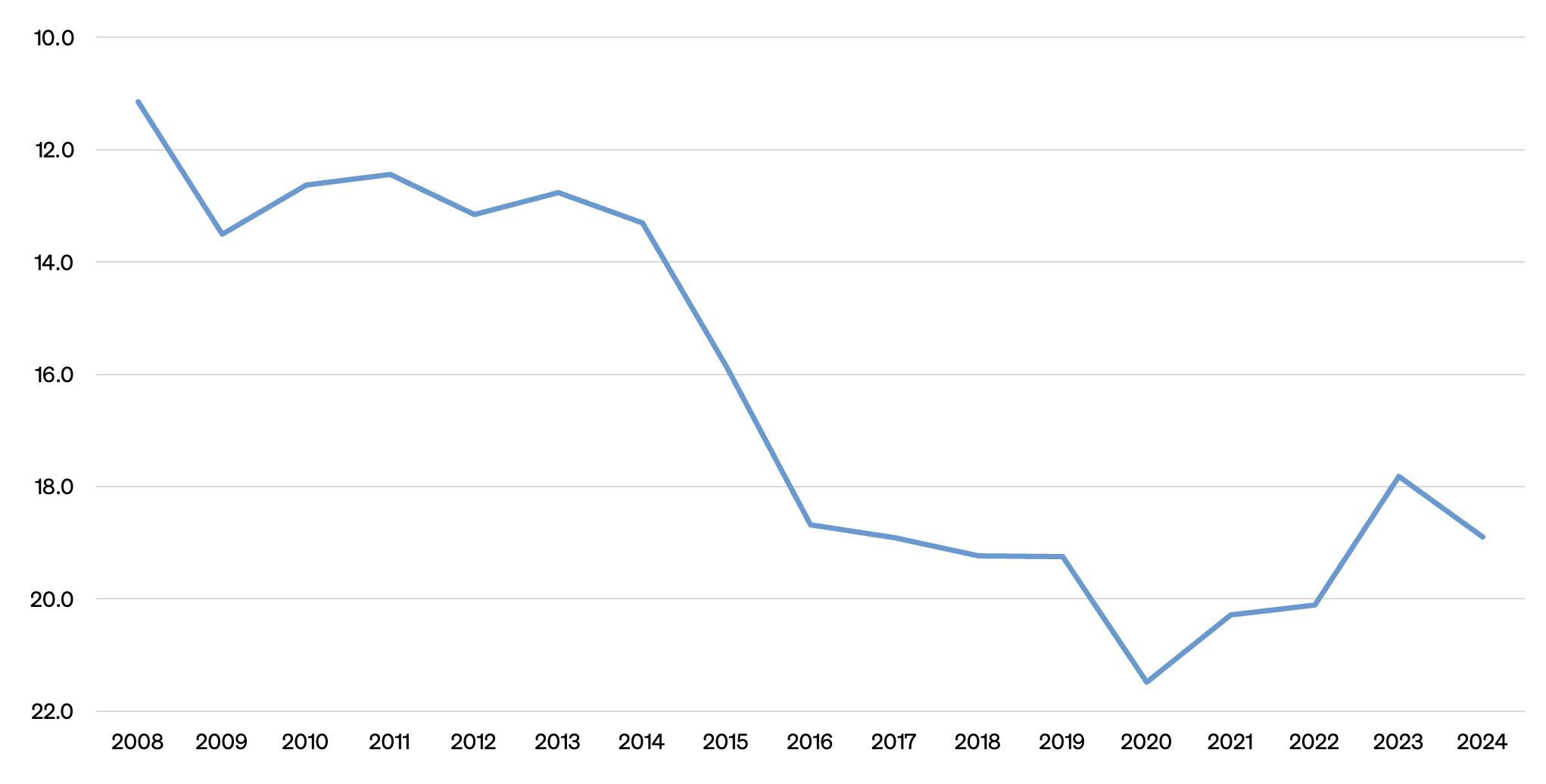
Notes: Authors’ estimates, 2024. Mexican peso per U.S. dollar average annually (inverted axis).
This reduction in the reference interest rate will slightly boost economic activity in Mexico. Still, the central bank will take time to reduce its interest rate, which is expected to be approximately 8.75% by the end of next year.
Remittances to the Rescue … Again
A country’s current account balance as a percentage of GDP is a measure of its international competitiveness, since it is a record of its transactions with the rest of the world. In Mexico, this figure is likely to be -1.2% (a deficit) in 2023, and we estimate Mexico’s current account balance will be almost the same in 2024, at approximately -1.1%. This deficit would be higher if not for the flow of remittances and FDI through nearshoring activity. These factors will help Mexico achieve a lower deficit next year.
In fact, remittances will continue to be one of the main drivers of the Mexican economy in 2024. In 2023, they reached a historic high of $63 billion. They have become one of the most important sources of currency and income in Mexico, second only to manufacturing, and could hit $67 billion next year.
Unlike other foreign exchange income, such as FDI, oil exports, and international tourism, remittances have not decreased since the start of the pandemic. In 2023, remittances represented approximately 3.8% of the national GDP. Due to inflation and the strength of the Mexican peso, however, their purchasing power fell around 11% compared to 2022. By contrast, 2024 will see a rise in the purchasing power of remittances thanks to a slight depreciation of the peso and a decrease in inflation.
Fiscal Austerity? Not Anymore!
Austerity was a central feature of the López Obrador administration. But the federal government plans to loosen its finances in 2024 to increase social spending ahead of the June elections and finish the president’s large projects. In addition, the government has incurred enormous liabilities through generous increases in pensions.
2024 will thus see government spending (9 trillion pesos) exceed revenues (7.3 trillion pesos). The result will be a higher deficit. The federal government is expected to have a real growth of 7.8% in public spending but only 0.8% in public revenues over 2023. This means the primary deficit in 2024 will be approximately 1.2% of GDP, and the fiscal deficit will be approximately 4.9% of GDP — the highest since 1990. The Mexican government expects the Historical Balance of Public Sector Financial Requirements (the broadest debt measure) to be above 48.8% of GDP.
This data shows the fragility of Mexico’s public finances in the coming year. The next administration will have to raise more revenue, either by establishing new taxes or increasing existing ones.
Figure 4 — Primary 2023 Economic Indicators and 2024 Estimates
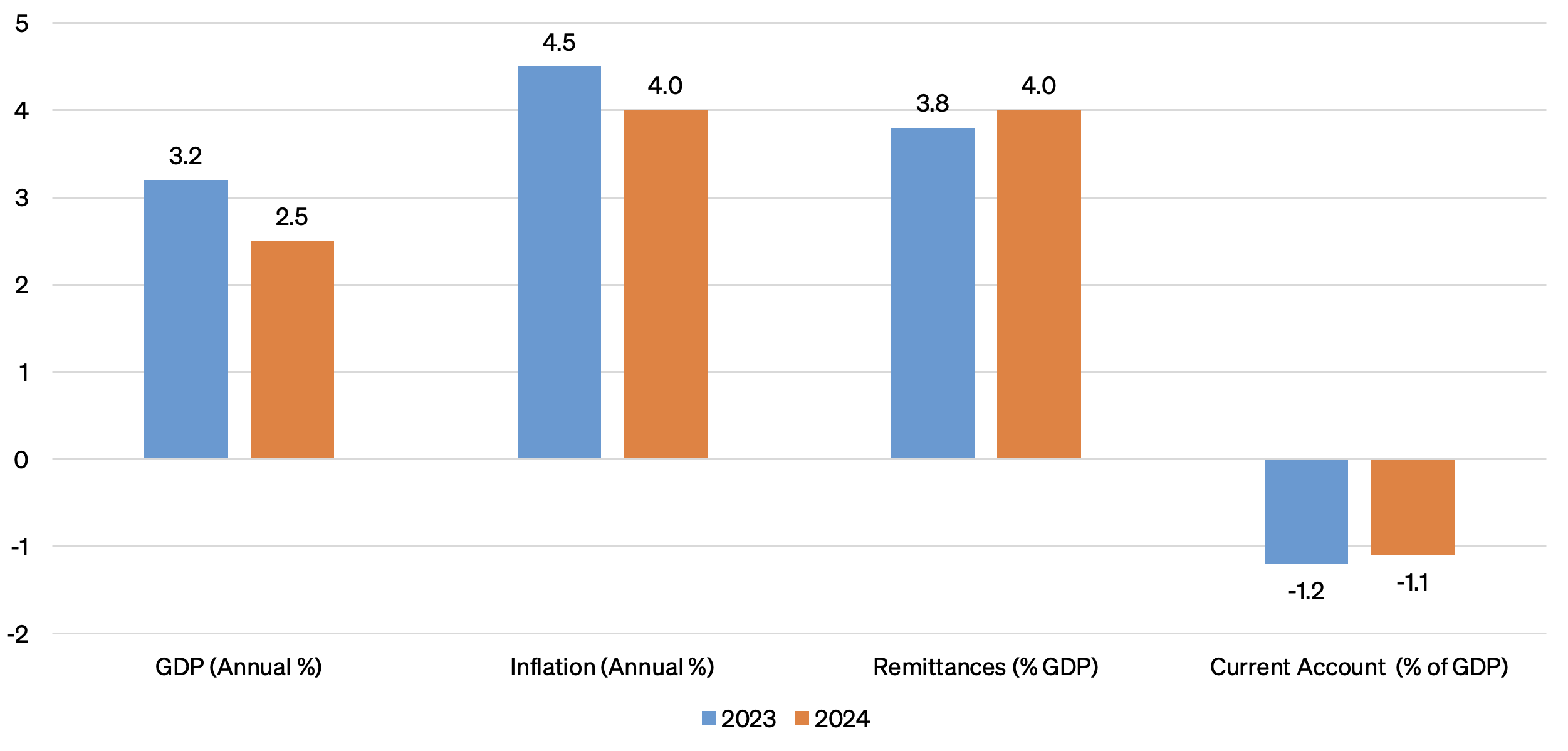
Notes: Authors’ estimates for 2024.
V. Investment and Trade Issues
Next year, Mexico will likely continue to be the United States’ largest trading partner and see new FDI thanks to multiple incentives for nearshoring. These incentives are a result of the U.S.-China trade war and associated tariffs, environmental constraints, supply chain adjustments, and a worsening business environment in China.
However, we do not expect new FDI to see its full potential, thanks to high levels of violence and insecurity, lack of infrastructure, and other factors that are discussed below. Moreover, several trade and investment disputes will be significant for U.S.-Mexico relations in 2024.
Energy Markets
The López Obrador administration has sought to roll back the 2013 reforms by the Enrique Peña Nieto administration and restore the near-monopolies of Pemex and CFE that date back to the 1960s. In June 2022, the U.S. and Canada formally charged Mexico with violating multiple provisions of the USMCA in its treatment of foreign investment in the petroleum and clean energy sectors. After the 90-day consultation period triggered by their charge expired, the U.S. and Canada could have formally requested the formation of a dispute settlement panel under USMCA Chapter 31. However, neither country has done so, apparently preferring to avoid exacerbating the dispute and threatening Mexico’s cooperation on other issues (such as unauthorized immigration).
Mexican Corn Exports
In August 2023, after several years of fruitless negotiations, the U.S. formally requested a USMCA panel to address Mexico’s intended ban on genetically modified corn. The U.S. alleges that the ban would violate its commitments under the treaty.
Mexico’s decree bans genetically modified white corn, which is used primarily for human consumption. But the U.S. is concerned that a ban on yellow corn, which is used largely for livestock feed and makes up 90% of U.S. corn exports to Mexico, could follow a ban on white corn and cause a significant decrease in overall U.S. corn exports to Mexico.
The U.S. argues there is no credible evidence that genetically modified grain is dangerous to human health, either directly or through human consumption of animals fed with it. Mexico differs, citing many studies that purportedly show danger to humans.
The panel could rule as soon as March 2024 but may require more time to assess what promises to be an enormous volume of submissions arguing each side. At present, Mexico lacks sufficient port infrastructure to replace U.S. corn imports with grain from Argentina, Brazil, Russia, or Ukraine, even assuming that adequate supplies are available.
US Auto Manufacturing
In a case brought by Mexico and Canada against the U.S., a USMCA panel ruled in December 2022 that the United States’ interpretation of certain rules of origin affecting the manufacture of autos and auto parts favored U.S. producers over Mexican and Canadian producers and was thus inconsistent with USMCA rules. As of October 2023, the U.S. had not implemented the ruling. Because of staunch support for the United States’ position by U.S. labor unions and their advocates in Congress, many observers believe it unlikely that the U.S. will implement the ruling before the November 2024 election. Discussions among the three governments are presumably ongoing, however.
Labor Charges
The labor provisions of the USMCA and Mexico’s 2020 labor reform laws have resulted in a series of U.S. charges that individual Mexican enterprises (mostly in the auto parts sector) are not complying with new legal obligations designed to encourage effective collective bargaining and formation of independent unions. Most of these have been resolved cooperatively by the two governments. One charge in the mining sector, however, will be resolved through the “rapid response” labor arbitration mechanism in the USMCA.
At the time of writing, a panel has been formed, and the fast-track process has begun. It is expected to include virtual sessions and an in-person hearing in Mexico City before the end of 2023, but the proceedings will probably extend into 2024. Failure to comply with the ruling could eventually result in trade sanctions against the individual Mexican firms and potentially broader consequences. However, that seems unlikely to happen in 2024 for political reasons, even if Mexico loses the arbitration.
Mexican Tomato Imports
Mexican tomato imports to the U.S. have increased in recent decades. They have also been the subject of anti-dumping disputes for more than 30 years. An agreement suspending dumping duties was reached in 2019, and Mexican growers accepted limits on the volume of tomatoes exported to the U.S. and other conditions designed to reduce oversupply and artificial price-lowering in United States.
In September 2023, however, a large group of U.S. lawmakers called on the Commerce Department to terminate the suspension agreement and reinstate the dumping duties. Terminating the agreement would be harmful to Mexican growers as well as tens of thousands of U.S. workers in Texas, Arizona, and California whose livelihoods depend on the processing, warehousing, and transportation of Mexican tomatoes.
Not surprisingly, another group of U.S. lawmakers, mostly from Texas and Arizona, have publicly condemned the calls to terminate the agreement. It is too early to determine how the Joe Biden administration will react, given the different viewpoints among U.S. growers and agribusiness and the risk that López Obrador would retaliate against other U.S. interests (for example, in the genetically modified corn dispute).
Lithium Mining
In 2024, Mexico’s adverse treatment of foreign investors could be showcased by a claim brought under a 2009 Mexico-China investment treaty. The Chinese mining firm Ganfeng Lithium invested in nine lithium mining concessions in Sonora after these private investments became legal under changes to the Mexican Constitution in 2013. In May 2023, the López Obrador administration canceled all of the company’s concessions.
Predictably, Ganfeng has accused Mexico of violating Mexican and international law and denying it due process. If the Mexican government and Ganfeng do not negotiate a settlement (which could include some sort of joint development of the lithium deposits by Ganfeng and Mexican authorities), litigation could ensue, either in Mexican courts or under the 2009 treaty between China and Mexico.
The Mexican government hopes to establish lithium refining, and not just mining, in Sonora. But this prospect seems distant, given the billions of dollars that would have to be invested in refineries for it to happen. It is also unlikely that U.S. or Chinese investors would provide the necessary funds.
VI. An Underfunded Health Care Sector
Expect Lower Public Health Care Spending by 2024
The outlook for the Mexican health care system in 2024 is not encouraging. Public investment in health (2.8% of GDP) remains much lower than the level recommended by the World Health Organization (6% of GDP).
Mexico’s federal budget for 2024 allocates 2.8% of GDP to health care. This is the second-highest allocation for health spending seen during the López Obrador administration; during the pandemic, the government allotted 2.84% of GDP to the sector.
When accounting for required transfers to the Federal Treasury, however, health care spending for next year drops to 2.63%. Moreover, although his office proposed a 5.8% increase in the health care budget for fiscal year 2024 over 2023, López Obrador will likely further reduce or modify the budget given the broad powers granted to the executive branch to adjust budgets by the Chamber of Deputies.
In fact, approved health care budgets are usually reduced. The highest health care budget in Mexico’s history was approved in 2023. But by July, it had been adjusted to 373 billion pesos — a reduction of 19 billion pesos (5%) from the budgets for 2018, 2021, and 2022. Various health care programs were cut, and ultimately 2023 saw the most-reduced health care budget since 2009.
It is also possible that a portion of the health care budget will be spent on other priorities next year. In 2021, the Federal Income Law authorized depositing health care monies into the general fund without requiring that these resources be used exclusively on health care. As a result, in the past three years, health care resources deposited in the general fund have gone to nonhealth-care programs, with little transparency or accountability.
In all, it is highly probable that health care spending will be less than the amount approved for 2024. And even if the entire increase were spent, the institutions that provide services to Mexico’s poorest residents, such as the Ministry of Health or the Mexican Institute for Social Security (IMSS)’s Bienestar, will see a budget growth of just 2.2% (8 billion pesos) in 2024 compared to 2023. Meanwhile, IMSS, the Institute for Security and Social Services for Government Workers (ISSSTE), the Ministry of National Defense (Sedena), and the Navy, which all serve the insured population, will see a budget increase of 7.8%, or 45 billion pesos.
Low public investment and the elimination of the public health care insurance program will be the main barriers to health care improvements in Mexico next year. The second barrier in particular deserves attention. The López Obrador administration ended Seguro Popular, the health care insurance program that gave near-universal health care coverage, in 2020. It sought to replace it with a program through the Health Institute for Wellbeing (INSABI), but the effort failed. It then sought to replace it with IMSS-Bienestar, but that effort too is failing. As a result, access to health care will continue to decline in 2024. The most affected will be the poor and uninsured.
Figure 5 — Health Spending as a Percentage of GDP in OECD Countries (2022)
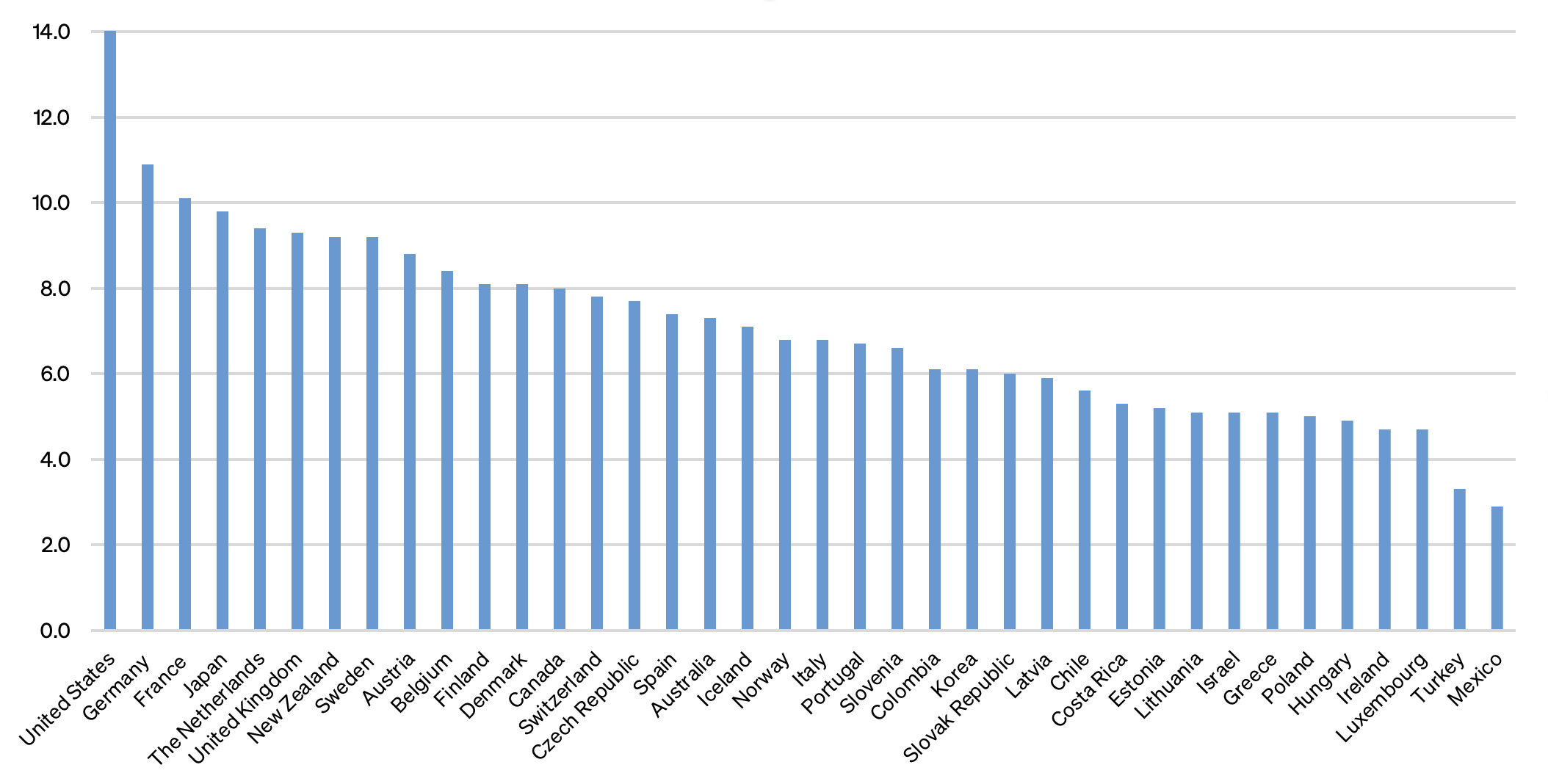
Public Health in Decline
Mexico’s health care indicators are continuing to decline. In 2018, 20 million Mexicans (16.2%) had no health insurance. This increased to 35.6 million (28.2%) in 2020 amid the COVID-19 pandemic. By 2022, the number of uninsured reached 50.3 million (39.1%). In 2024, this number will likely remain the same, as there are no existing programs to increase the number of insured residents.
Public health is also measured by the number of doctor appointments scheduled. By the end of 2023, the number of health care appointments will remain below the level observed in 2018, and doctor appointments are expected to fall for both the insured and uninsured in 2024. This decrease will be larger for the uninsured; doctor appointments for this group are expected to fall 36% (45.5 million) compared to 2018, while for the insured, they will fall by 9% (15.8 million).
This indicates a worrying setback in health care access, as health conditions have not necessarily improved. Postponed health care often results in worsening health trends and higher death rates.
The decline in public health can be attributed to the cancellation of Seguro Popular and the failure of its replacement program. This policy failure forced millions to seek care in the private sector, where it is more expensive, or otherwise forgo health insurance. In 2022, 59.9% of Mexicans sought medical care in the private sector, 13.3% more than in 2018. This is a de facto privatization of health care, which impacts Mexico’s most marginalized communities. Mexicans must now dedicate 4.2% of their income to health care, 1.3% more than in 2018. In 2024, this pattern will continue.
Mortality Rates
Based on information from the Institute for Statistics, Geography, and Information (INEGI), the mortality rate in Mexico in 2022 flattened compared to 2021. However, it remains high in comparison with the years prior to the COVID-19 pandemic. Heart disease, diabetes mellitus, and cancer are among the country’s leading causes of death. The mortality rates observed for these diseases were lower in 2022 than they were in 2021, but remained above 2019 numbers, and the rate for heart disease in particular was considerably higher. No real improvements should be expected in 2024.
Household Economic Impact as Health Care Investment Declines
Mexico’s poorest households will continue to face catastrophic health expenses in 2024. They can expect to allocate more than 30% of their disposable income to care for a family member’s chronic illness or to finance treatment.
These expenses can be ruinous for Mexico’s poor. They will very likely force families to sell or pawn assets, including homes, and they can be expected to perpetuate or deepen poverty.
In 2018, 677,000 of Mexican households (2% of the total population) incurred devastating health care expenses. This figure went up to 3.7% (1.3 million households) in 2020, with a slight improvement in 2022 (2.7% or 1 million households). These impacts can be traced to the elimination of Seguro Popular. With no effective replacement in the works, the outlook for 2024 is the same.
VII. Continued Failure to Develop Talent
Mexico’s education system will face the same challenges in 2024 as it has in the past: unequal access to technology, low-quality and ideology-driven content, and uneven implementation of curricula. In particular, unequal access to technology has a negative effect on students’ educational attainment and cognitive abilities.
A publication by the Federal Telecommunications Institute (IFT) showed that in the 13 Mexican states with the highest percentage of municipalities below the poverty line, only 67% of households have access to cell phones, and only 11% have access to computers. By comparison, in states with lower percentages of municipalities below the poverty line, 83% of households have access to a cell phone and 60% have computer access. This technology access gap between high- and low-income households and territories will continue to grow, and it can be expected to widen gaps in digital literacy and technological skills development. Future investment may close this gap, but not in 2024.
The quality of educational content will be an even greater problem. Quality of content is key to fostering high value-added activities and improving the quality of the workforce. The latest data available from the Programme for International Student Assessment (PISA) illustrates the low quality of Mexican education, with Mexican students scoring lower than the OECD average in reading, mathematics, and science in 2018. Socioeconomic level was a good predictor of performance in these same subjects.
For years, experts have pointed out the need to update educational programs and study plans. Instead, the federal government has supplied textbooks that reduce content in math, science, and technology while increasing ideological content and emphasizing outdated cultural values. This will likely create yet another gap, leaving public school students behind and accelerating the advantages of those who can afford private education.
Moreover, the public education budget is low. There are insufficient teaching staff, materials, infrastructure, and services in schools. For example, there is only 1 school for every 1,000 youth and only 1 teacher for every 34 secondary school students. Only 23% of secondary schools are in good standing. Finally, there has been no federal effort to reduce already-high dropout rates at all levels.
Is it possible to reverse the deterioration of Mexico’s education system and its decline in investment in science and technology? Likely not. For years, national and international organizations have pointed to Mexico’s decreasing annual education expenditures. Regular expenditure per student is well below the OECD average. In 2022, the average school expenditure per student was approximately 29,600 pesos ($1,470), compared to an average of $11,900 among OECD member countries.
It will take a long time to change course, especially if the federal government continues to decrease the education budget in real terms. In a scenario of underinvestment, efforts to transform and adapt new learning methods for students, implement strategies to adopt new technologies, and supply better infrastructure will continue to fail. Further, promoting ideological perspectives in elementary and middle school curricula will not have a positive impact on children’s learning. In turn, Mexico will not be prepared to attract high value-added firms and integrate into global value chains.
VIII. Frail Public Safety, Security, and Criminal Justice Systems
Transnational criminal organizations (TCOs) will continue fueling violence and insecurity in Mexico, resulting in serious crimes that will affect the public domain, tourism, multinational business, and migration. There are no signs of this abating in 2024.
In Mexico, TCOs are composed mostly of drug cartels. There are few crimes that happen in Mexico that are not tied to the cartels, which operate across a wide spectrum of criminal product lines and on a global scale.
In 2023, the Sinaloa and Jalisco Nueva Generación cartels were the two most visible and active TCOs in Mexico. Most Mexican cartels are allied with one of these two groups. We expect them to dominate the criminal landscape in 2024, and we expect this bipolar network structure (i.e., power concentrated in two competing cartels) to persist next year.
Politics and Corruption Drive Public Safety in Mexico, Not Policing and Rule of Law
If Claudia Sheinbaum is elected president in June 2024, she will very likely continue the policies enacted by López Obrador. As such, she can be expected to turn a blind eye to cartel activities and ignore the production, transportation, distribution, and sale of drugs, drug-related killings, homicides, femicides, kidnappings, and extortions.

Figure 6 depicts an overview of Mexico’s crime statistics, compiled by the National Citizen’s Observatory (ONC) from 2015–22. It shows that 2 in 4 major crimes against the public are homicides and extortions. The data also indicates that femicides (an outlier crime that captures the public interest enough to be labeled individually) and kidnappings have generally occurred at a steady rate over the past nine years.
Figure 6 — Intentional Homicide, Kidnapping, Femicide, and Extortion: Absolute Numbers of Victims (2015–July 2023)
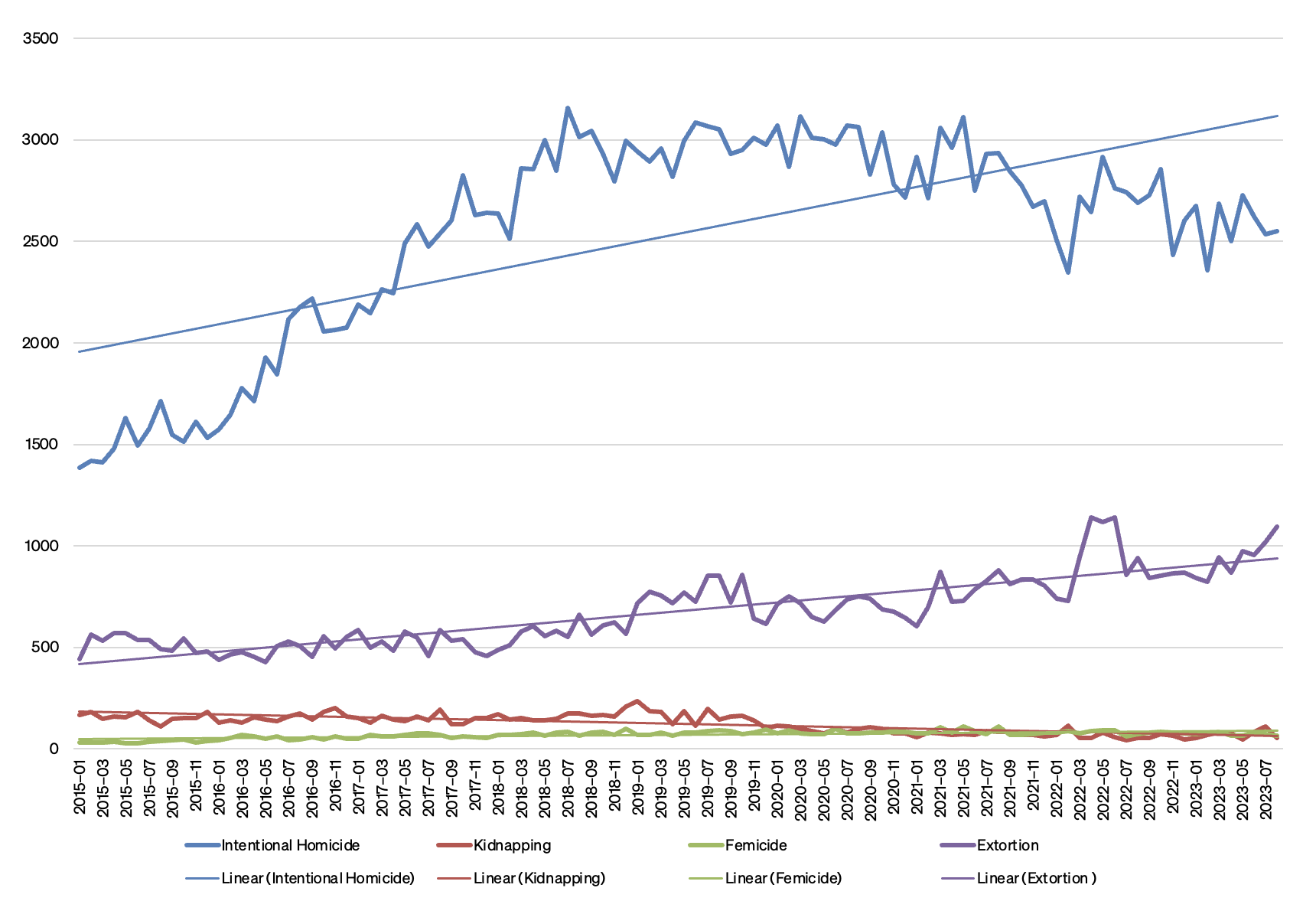
Homicides reached their peak when López Obrador took office in 2018. They remained at high levels (with over 3,000 victims during each of the ONC’s reporting periods) throughout his tenure, or at least until the end of 2022.
Extortions increasingly involve virtual crimes conducted via phone or Internet; these yield higher cash returns and are less complicated to perform than kidnappings. Extortions have also steadily increased since López Obrador took office. They peaked in 2022 and are continuing to trend upward.
Through acts of commission and omission, López Obrador continues to provide moral, if not underground, support to TCOs. For example, he has delivered statements denying that Mexican TCOs produce fentanyl, the most dangerous drug produced through the border trade thus far.
The U.S.-Mexico Bicentennial Framework for Security, Public Health, and Safe Communities was enacted in September 2021 and was heralded by Mexico as a new solution to address the countries’ bilateral security problem. The framework, as López Obrador desired, emphasizes solutions to drug demand over drug supply. It prioritizes rehabilitation and other ways of addressing drug abuse instead of focusing on ways to vigorously confront TCOs and bring them to justice. In the past two years, this framework has allowed TCOs to continue their criminal activity with little or no interference. This nonconfrontational approach is expected to continue in 2024 and beyond.
In recent years, the U.S. successfully prosecuted former Sinaloa drug lord Joaquín “El Chapo” Guzmán and his wife, extradited his son Ovidio Guzmán, and charged his other sons, known as “Los Chapitos,” with drug crimes. Meanwhile, aside from an occasional high-value target extradition, the Mexican federal government has continued to limit the activities and numbers of U.S. federal law enforcement assets and agents in Mexico, particularly from the U.S. Drug Enforcement Administration (DEA). These actions have included removing some DEA aircraft from Mexico, limiting the number of DEA staff in the country, stripping diplomatic immunity from all but the DEA Mexico country attaché, and limiting bilateral law enforcement liaison contacts through a strict reporting structure that has all but halted routine interaction among counterdrug agencies.
Extraditions might seem like evidence of binational cooperation, but in reality, little to no substantive cooperation, coordination, or communication has resulted. There is no doubt that diplomacy through the Bicentennial Framework fosters dialogue, but recent extraditions can be better understood as empty gestures by the Mexican government. They benefit Mexico politically while allowing justice to be served elsewhere, particularly in the United States.
In fact, since 2021, López Obrador has done more to dismantle bilateral security cooperation than to increase collaboration with Washington. His actions call into question the seriousness of his public safety and security policies and lead analysts and observers to suspect there is collusion between government and organized crime in Mexico.
We expect López Obrador to continue to disregard the possibility that TCO activities are a real threat to Mexico’s democracy and national sovereignty. In certain nonsecurity-related matters, Mexico has seen relative success and cannot be considered a failed state. But the country could reach failed state status if Mexican TCOs were to topple the government with their combined criminal armed forces. These TCOs possess an arsenal of weaponry equal to or exceeding the capabilities of Mexican defense and police forces, and can hold this as a trump card to ensure their continued existence.
Things to Watch for in 2024: Drivers of TCO Profitability
Cartel Evolution
Next year, we expect to see major disruptions to the organizational structures of the Sinaloa and Jalisco Nueva Generación cartels and continued diversification of their operations. The shifting criminal landscape could lead to surges in violence. In the election year, political assassinations and threats against candidates to make them pull out of elections, which we saw in 2018, will rise. Violence will be highest where incumbent candidates are weaker and likely to be unseated, since shifts in political party power interrupt existing political-criminal agreements.
Increased Drug Production
The amount of fentanyl produced in Mexico and seized at the U.S. border and interior will remain at current levels or increase in volume in 2024. On Oct. 2, 2023, Los Chapitos (who the DEA have identified as the primary producers of fentanyl in Mexico) hung “narcomantas,” or banners with cartel messages, in the state of Sinaloa that claimed the production of fentanyl had been banned. Regardless of motive, it is doubtful that the Sinaloa cartel will cede any profits generated from fentanyl or any other drug production activities next year.
Increased Crime
Crime and violence are expected to remain problematic in the northern border states, where conflicts for territorial extortion rights (“derecho de piso”) abound. We will likely see an increase in TCO activities in the Yucatan Peninsula and on the southern border of Mexico with Guatemala. The proposed Mayan Train will provide TCOs with increased opportunities to exploit the transportation system by charging fees, or “cuotas,” as a form of extortion to allow undisturbed operations. Migration through Guatemala will provide TCOs with continued revenue from human smuggling.
Unabated Migration
TCOs and corrupt Mexican authorities benefit substantially from allowing migrants to travel through Mexico on their way to the United States. On average, migrants pay $4,000 to be transported into the country. Considering the number of migrants that have crossed into the U.S. in recent months, TCOs and corrupt government contacts have collected billions of dollars in revenue in this line of criminal business.
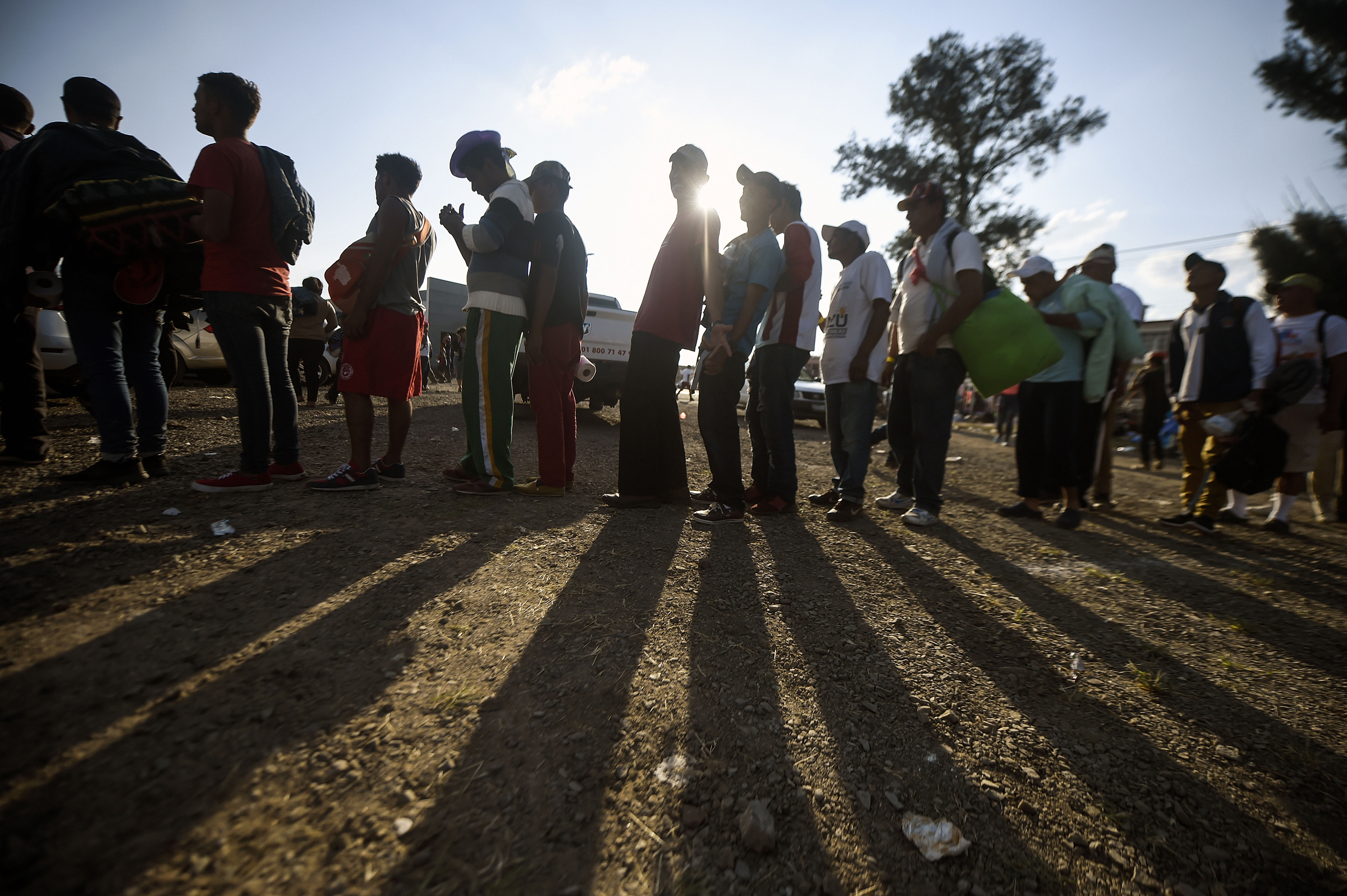
On Oct. 2, López Obrador stated that 10,000 people were arriving at the U.S. border every day. If that is true, those numbers represent 14 billion pesos ($600 million) in annual revenue for the human smuggling business, which is operated by various TCOs who vie for territory, or “plazas.” 2023 saw a surge of migration; the numbers will continue to grow, and crimes such as extortion, kidnapping, rape, and other depravities against migrants will also continue or increase in 2024. Meanwhile, the Mexican federal government will provide migrants with little or no security or safety.
International Cooperation
We do not expect to see Mexico substantively cooperate, coordinate, or communicate with the U.S. on a long-term strategy to neutralize TCOs through the courts or any other means, despite repeated promises made to the U.S. government. The country’s “Abrazos, No Balazos” (Hugs, Not Bullets) policy — a nonconfrontational stance against organized crime — will remain in effect in 2024, and TCOs, which sponsor most crimes in Mexico, will continue to operate at will, with only token cooperation with the U.S. expected from the Mexican government.
Decoupling from the US
We may see other Latin American governments engage with Mexico as counter-drug policy development evolves in 2024. Under President Gustavo Petro, Colombia has proposed a regional drug policy alliance for South America that more closely aligns with Mexican interests. For example, Petro and López Obrador both prefer to emphasize drug demand, rather than drug supply, in their policies.
Under López Obrador, the U.S.-Mexico Bicentennial Framework for Security, Public Health, and Safe Communities has achieved the opposite effect of what the supply-side model for disrupting and dismantling TCOs intended. The president has torn apart bilateral law enforcement cooperation and set back decades of U.S.-Mexico partnership, including the achievements gained under earlier administrations.
TCO-sponsored crimes against people, human smuggling, and drug production are at all-time highs, and 2024 will likely see these trends continue or increase. Criminal justice in Mexico is frail, and Mexican institutions are largely uncommitted or unengaged in meaningful public safety efforts.
IX. Struggle to Achieve Energy Self-Sufficiency
Energy will be a key topic in the lead-up to the June 2024 election. Driven by his desire to hand power to his MORENA-led coalition, López Obrador will try to double down on his energy policies, no matter the cost.
As a result, priority will likely be given to projects that are perceived to be more profitable from an electoral perspective, such as finishing the construction of the Dos Bocas refinery. The federal government’s policies and decisions will also seek to further shield Pemex and CFE from private competition. But, despite López Obrador’s nationalist rhetoric and policy actions, the energy sector will continue to face its current challenges, underinvestment and unproductive subsidies, through 2024. The dire financial situation of Pemex will also continue (Figure 7).
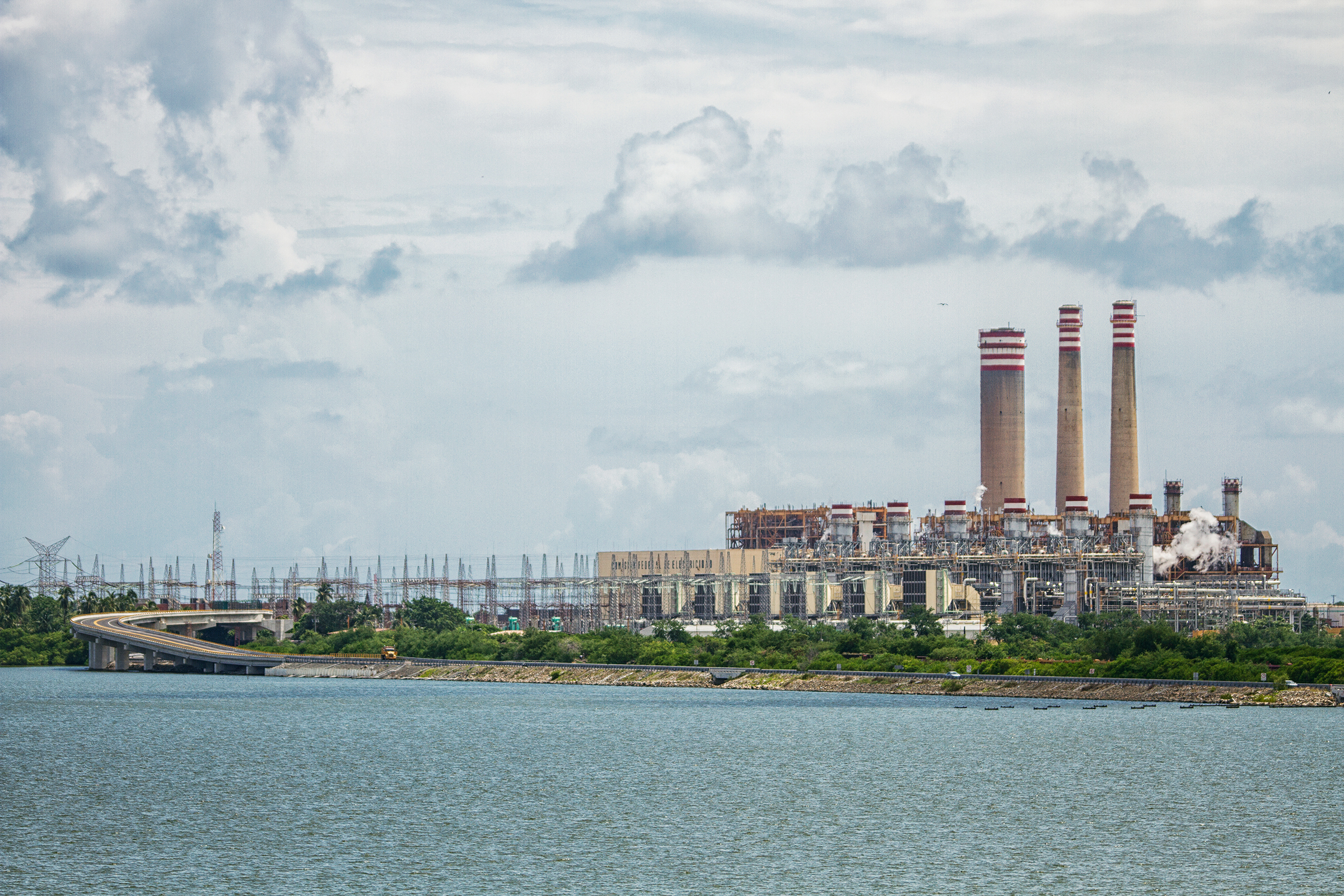
As illustrated in Figure 7, Pemex’s balance sheet has worsened under López Obrador’s watch. From December 2018–June 2023, the national oil company’s overall liabilities grew from $179.5 billion to $225.3 billion. However, its main concern in 2024 lies in its short-term obligations. Considering both financial debt and debt with suppliers, these amounted to $43.7 billion in June 2023, up from $17.2 billion in December 2018.
Figure 7 — Pemex Financial Debt and Liabilities (in Billions of US Dollars)
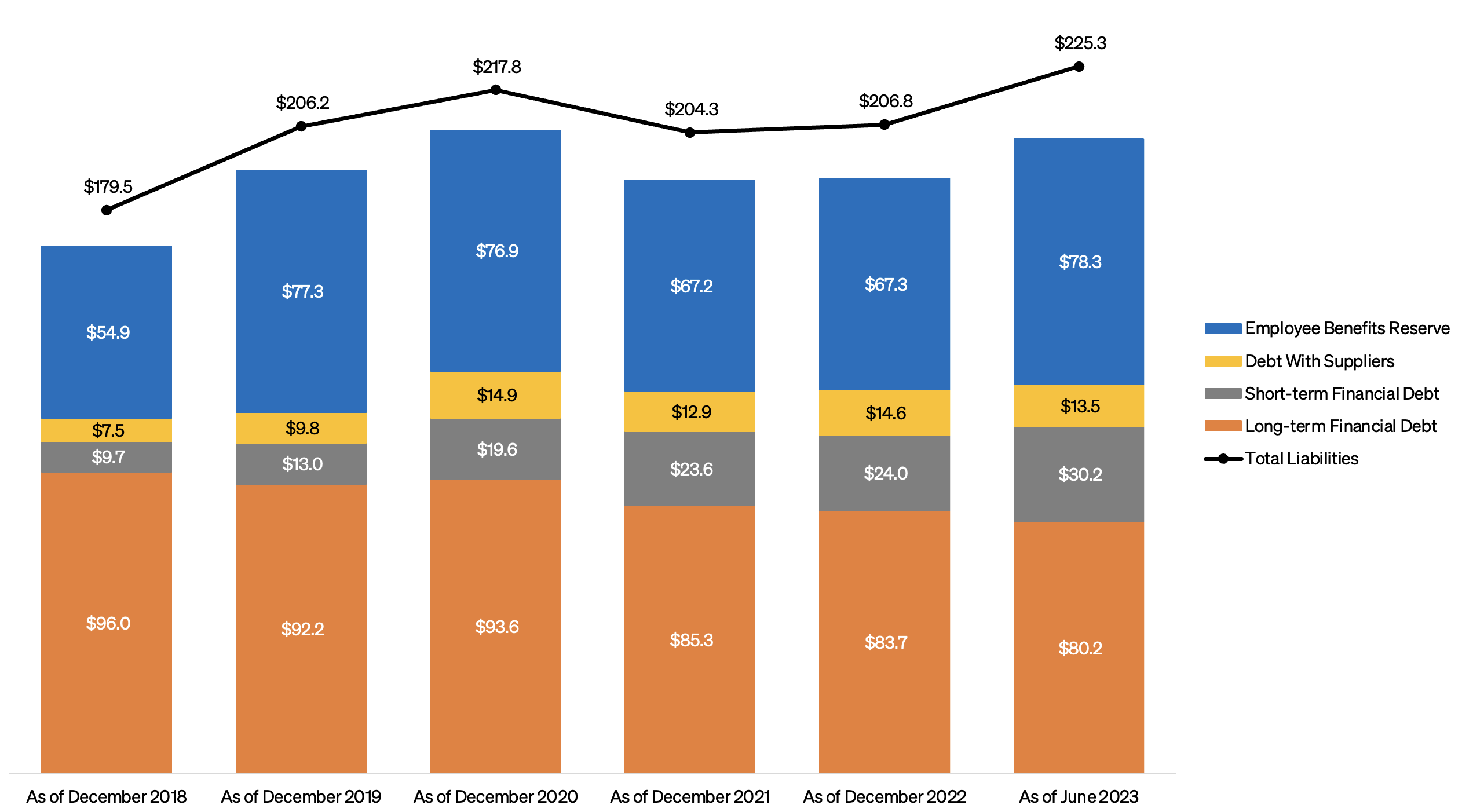
Based on the grim financial outlook for Pemex in 2024, we anticipate that the federal government will fall short in its goal to increase fuel and crude oil production to intended levels. In other words, the company’s capacity to enhance its operative performance will be affected by 1) a limited scope to boost total capital expenditures, which in 2024 will be roughly 49% lower than in 2023 (Figure 8), and 2) the absence of a long-term scheme to cope with its financial obligations. From July 2023–June 2027, Pemex is expected to pay 51.6% of its financial debt, meaning it will require additional capital injections throughout that period.
With respect to Pemex’s refining operations, Mexico’s proposed 2024 budget considers a reduction of approximately 41% in capital expenditures compared to 2023. In that context, the outlook for Pemex to boost fuel production in its existing refineries, a core objective of López Obrador’s energy ambitions, looks rather complex. But production figures could be increased, given that for him, it is more meaningful from an electoral perspective to complete the construction of the Dos Bocas refinery in his home state.
At the time of writing, it remains unclear if, thanks to the extraordinary resources allocated through Mexico’s Secretariat of Energy (SENER), the Dos Bocas refinery will be fully operational in 2024. Considering Pemex’s record in managing its construction, budgeting, and other domestic refineries, the start of operations will likely be deferred to 2025.
In short, the risks associated with Pemex’s financial and operative shortcomings will certainly reverberate beyond 2024. The next administration will deal with a company plagued with inefficiencies, which will prevent the company from becoming profitable in its own right in the long run.
The question is: What is the plan for Pemex and the energy sector at large? In the months leading up to the June 2024 presidential election, Mexicans will be exposed to different proposals from the candidates. While the MORENA-led coalition cannot afford to propose a policy shift, opposition candidates will be inclined to limit the influence of Pemex and CFE in their respective markets. We anticipate a highly divisive discussion around energy issues in 2024.
The power sector faces its own set of challenges. For Mexico to take full advantage of the geographical reconfiguration of supply chains triggered by the U.S.-China trade dispute, the deployment of renewables and the expansion of transmission lines must gain momentum. In light of the 2024 election, however, we expect the official narrative from MORENA and its presidential candidate to remain centered on the importance of fossil fuels.
Nonetheless, power demand increases and a huge dependence on natural gas imports are both set to persist in 2024 and beyond. With that in mind, it is premature to dismiss the possibility that Mexico’s new president will encourage a greater share of renewables in the country’s energy mix.
Figure 8 — Pemex Capital Expenditures (in Millions of Mexican Pesos)
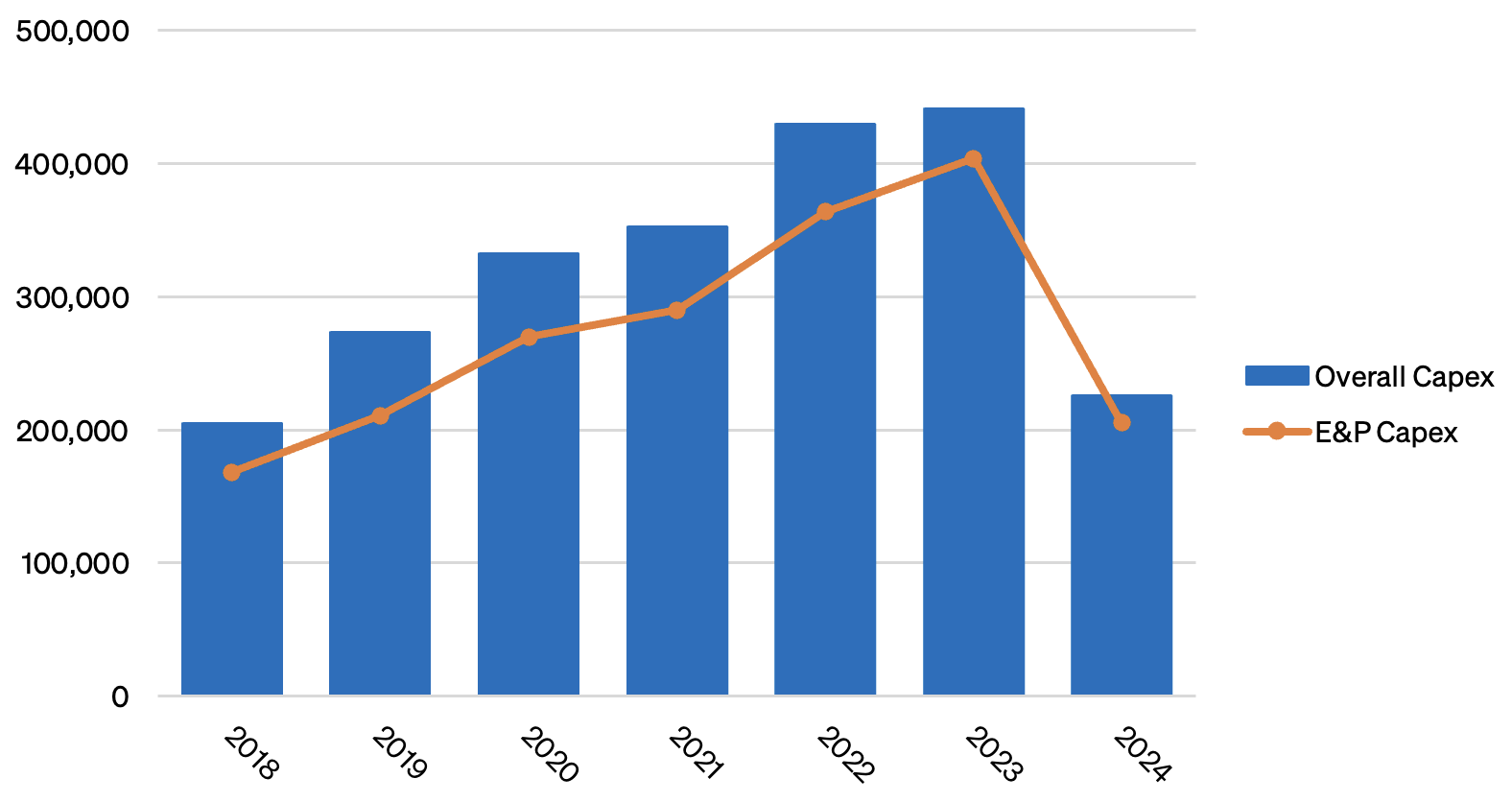
Note: Capex values as presented by the Secretariat of the Treasury and Public Credit (SHCP) in its different budget proposals submitted to Congress.
X. Testing the Limits of Binational Relations
After a quarter-century commercial alliance and varying degrees of cooperation on security and immigration, as well as implicit geostrategic overlap, the U.S. and Mexico have entered into a more difficult relationship. This was largely caused by the anti-Mexican rhetoric of President Donald Trump and the soft anti-Americanism of López Obrador. Binational cooperation has ebbed and flowed, but in general, the two countries are experiencing a low-intensity political and diplomatic impasse. This is due to several factors that will continue to determine the course of the relationship through 2024:
- Mexico’s low enthusiasm for Washington’s aims to stem the flow of irregular migration, combat fentanyl smuggling, and resolve simmering trade disputes. These disputes encompass energy, agriculture, and China’s increased interest in Mexico, particularly in steel and aluminum through Mexican exports to the United States.
- Mexico’s flirtation with Latin American dictators for whom the U.S. government has a general dislike. These include Nicaraguan President Daniel Ortega, Cuban President Miguel Díaz-Canel, and Venezuelan President Nicolás Maduro. Mexico’s neutral attitude toward U.S. geostrategic interests in Ukraine, Israel, and East Asia have also irked Washington.
- Other foreign and domestic distractions for the United States. The U.S. has been willing to give Mexico a pass on various issues in order to avoid opening a new political and diplomatic front, largely because doing so would bring few gains and consume too much energy.
- A lack of energy for resolving binational disputes. Neither country has moved to appoint more-competent diplomatic teams to work through their disagreements. We expect that in 2024, as before, the U.S.-Mexico relationship will be managed enough to ensure that disagreements do not turn into major conflicts, but its managers will not necessarily take it to another, higher level of cooperation.
Of course, Mexico understands that U.S. investment, access to U.S. consumer markets, and growing remittances from Mexican migrants in the country play a major role in keeping its economy afloat. For this reason, it is not in Mexico’s interest to upset Washington. Instead, Mexico will continue to drag its feet when it comes to U.S. interests, and the U.S. will continue to allow the private sector to lead the way in dealing with Mexico, with some government support at key points.
With the June 2024 elections in Mexico and the November 2024 elections in the U.S. in mind, domestic politics on both sides of the border will likely make the binational relationship more difficult next year. Mexico will be front and center for Republicans, who have advocated for direct intervention to deal with immigration, fentanyl, and organized crime in Mexico, all of which clearly affect the United States. We expect that Republicans will continue to verbally attack Mexico during the 2024 U.S. presidential campaign and criticize what they see as the Biden administration’s lenient border policy.
In sum, 2024 will likely see no significant changes to the binational relationship, which will continue at a lethargic level of cooperation that neither boosts it forward nor pushes it toward greater conflict. However, this state of affairs may allow disagreements to gradually worsen, meaning more energy will be required to address tensions in 2025 and beyond. In the end, the defining characteristic of the U.S.-Mexico relationship in 2024 will be a “muddling through” approach.
XI. Brewing Crises at the US-Mexico Border
The shared U.S.-Mexico border will be the greatest source of binational conflict in 2024. Two issues will dominate dynamics at the borderlands:
- Ongoing mass migration. While the Biden administration will likely continue to close the southern U.S. border and deport migrants en masse, Mexico can be expected to continue its lax policy of allowing migrants to transit through its interior. It will also likely permit organized crime to play an ever-increasing role in smuggling migrants toward the U.S. border. Washington will continue to pressure Mexico to cut the flow of irregular migration, but Mexico will continue to drag its feet on the issue. The hundreds of thousands of migrants that transit through Latin America to Mexico and the U.S. border will be the most important irritants in the binational relationship. This could invite more aggressive action from the Biden administration, given that most Americans think he has not handled the border well.
- The drug trade. The Biden administration will continue to seek Mexico’s cooperation to interrupt the flow of drugs across the U.S. border, especially fentanyl. For its part, Mexico will continue to decline responsibility and even deny that the fentanyl trade is an issue that it should work jointly with the U.S. to resolve.
Despite U.S. pressure, the López Obrador administration simply will not confront organized crime around these two issues, which directly affect American interests. This is largely because the president’s party, MORENA, expects organized crime to operate in its favor during the 2024 elections. As a result, there will be very little progress on a framework for joint management of border issues.
However, the U.S. states, and Texas in particular, will take matters further in 2024. Texas Gov. Greg Abbott has taken specific measures to challenge the Biden administration’s border policy, specifically on irregular migration and fentanyl. In doing so, he has punished binational commercial interests. Given Abbott’s current political capital, more actions against these interests should be expected in 2024, as they are the only way the governor has found within his powers to deal with complaints about the border.
XII. Conclusion
2024 will see important political and economic opportunities for Mexico. It will also see perilous moments, not the least of which are the 2024 elections in both Mexico and the United States. In Mexico, the June 2 elections will be an opportunity to correct the country’s current political trajectory; in the U.S., the Nov. 5 elections will be an opportunity to reaffirm a commitment to democracy. Economically, the U.S. will likely continue pursuing industrial policies that allow it to pivot away from Asia. For Mexico, this will represent an opportunity to further couple its economy with that of the United States. If it does so, it could profit handsomely.
The major challenges for Mexico and U.S.-Mexico relations will be self-imposed, whether in the political-electoral arena or in economic policy. Whatever happens in 2024, the year will be decisive for the binational relationship. Despite growing mutual distrust, Mexico needs the U.S. as a partner to continue its path to development. Similarly, the U.S. needs Mexico to successfully carry out its industrial policy and solve key binational issues, such as irregular migration and drug trafficking.
This material may be quoted or reproduced without prior permission, provided appropriate credit is given to the author and Rice University’s Baker Institute for Public Policy. The views expressed herein are those of the individual author(s), and do not necessarily represent the views of Rice University’s Baker Institute for Public Policy.


